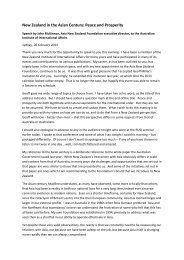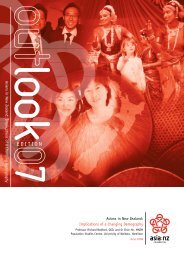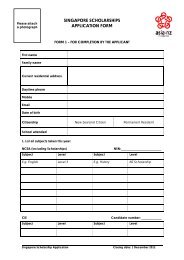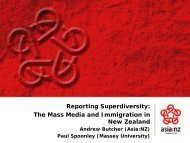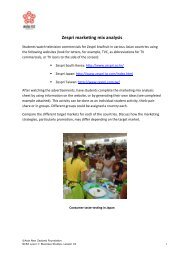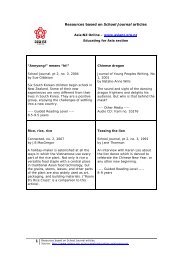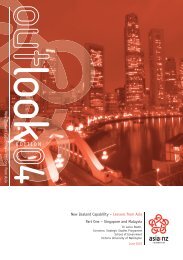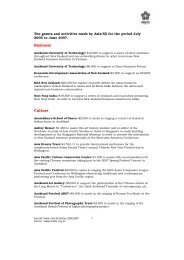1 Myanmar - looking to realise its full potential By Sajini Jesudason ...
1 Myanmar - looking to realise its full potential By Sajini Jesudason ...
1 Myanmar - looking to realise its full potential By Sajini Jesudason ...
You also want an ePaper? Increase the reach of your titles
YUMPU automatically turns print PDFs into web optimized ePapers that Google loves.
<strong>Myanmar</strong> - <strong>looking</strong> <strong>to</strong> <strong>realise</strong> <strong>its</strong> <strong>full</strong> <strong>potential</strong><br />
<strong>By</strong> <strong>Sajini</strong> <strong>Jesudason</strong>, Wigram Capital Advisors<br />
The world has been transfixed by <strong>Myanmar</strong>'s sudden and dramatic opening over the past 24<br />
months. The country has seen a number of vital breakthroughs in the political sphere – the first<br />
general election in 20 years in 2010; the opening of the current parliament in January 2011; and<br />
the participation of the opposition party National League for Democracy in the April 2012<br />
by-elections (where the party won 43 of the 45 parliamentary seats contested). These political<br />
reforms, combined with the release of political prisoners and the successful negotiations of<br />
ceasefires between the Burmese military and ethnic groups, have been closely followed by the<br />
easing of (or promises <strong>to</strong> ease) numerous foreign sanctions.<br />
Paralleling these political reforms is the commitment <strong>to</strong> economic reform. <strong>Myanmar</strong> was once<br />
one of Southeast Asia's richest nations, strategically situated on the crossroads bordering China<br />
and India. <strong>Myanmar</strong> facilitated the movement of goods and people between smaller Asian<br />
nations, India and China. Prior <strong>to</strong> the military coup of 1962, the country had a strong economy<br />
coupled with a high level of education and an established legal system. Today, the country<br />
struggles with a per capita income of less than US$750 (based on Asian Development Bank (ADB)<br />
forecasts), one of the lowest in the region. Yet though <strong>Myanmar</strong> is a poor country, poverty is not<br />
as crippling or degrading as in some parts of South Asia.<br />
To support the political reforms already under way, priority must be given <strong>to</strong> economic changes<br />
that quickly raise incomes and reduce poverty. While significant economic reforms are necessary,<br />
the immediate priorities are the development of the non-gas sec<strong>to</strong>r – principally light<br />
manufacturing and agriculture – price liberalization, and support of private enterprise. This will<br />
go a long way <strong>to</strong>wards delivering immediate gains for the wider population.<br />
The reforms that will unlock the country's <strong>full</strong> natural resource <strong>potential</strong> will involve changes<br />
over a longer term, including institutional reform, infrastructure spending and much technical<br />
assistance <strong>to</strong> ensure the proper sequencing. The reforms required are extensive, and will need a<br />
stronger institutional infrastructure and will be slower <strong>to</strong> implement. To rush the reform process<br />
will risk political instability that the country can ill afford. The lesson from neighboring countries<br />
is that economic reform and “opening up” is a challenging process that requires<br />
multi-dimensional policies and astute navigation.<br />
<strong>Myanmar</strong>’s current economic position is difficult <strong>to</strong> analyse because of the poor quality of official<br />
statistical data, so many economic conclusions are at best tentative.<br />
According <strong>to</strong> official gross domestic product data collated by the <strong>Myanmar</strong> Central Statistical<br />
Organisation, <strong>Myanmar</strong>’s real GDP for the past 10 years is an unverifiable 9.7 percent. In some<br />
years, the country's growth rate is shown <strong>to</strong> be above that of China and India – casting doubt on<br />
the reliability of the data. More reliable are IMF staff estimates that use data commencing from<br />
2007/8. This shows the real GDP growth rate averaging 5 percent since 2007 and forecast at 6<br />
1
percent for the 2012/2013 financial year. The International Monetary Fund (IMF), World Bank<br />
and ADB all forecast growth at 6 percent or greater in 2013 based on ongoing reforms, higher gas<br />
exports and increased foreign investment in the energy sec<strong>to</strong>r (hydro, gas and oil).<br />
Much of <strong>Myanmar</strong>'s current economic activity is based on energy and agriculture. The ADB<br />
estimates the agricultural sec<strong>to</strong>r at close <strong>to</strong> 40 percent of GDP but some private sec<strong>to</strong>r analysts<br />
estimate it <strong>to</strong> be closer <strong>to</strong> 70 percent. Much of the country's population is in the rural sec<strong>to</strong>r.<br />
There has been little or no urbanisation since the 1960s.The gains of the natural resource sec<strong>to</strong>r<br />
have not translated in<strong>to</strong> reinvestment in poorer agriculture-based rural areas, with little<br />
electrification or infrastructure investment. The financial sec<strong>to</strong>r is rudimentary, and the banking<br />
sec<strong>to</strong>r both underdeveloped and constrained by severe institutional limitations.<br />
Like the GDP data, official inflation data is also understated. Official data is based on 1986 prices<br />
of a consumption basket covering only the capital, and was reset <strong>to</strong> zero in 2006 giving a current<br />
CPI of 7 percent, a figure consistent with IMF and ADB estimates. However, underlying inflation<br />
is undoubtedly higher, as money supply growth is persistently over 30 percent (IMF), reflecting<br />
that the fiscal deficit is funded by printing money.<br />
<strong>Myanmar</strong> is in need of the classic monetary reform, it is a transition economy and faces the<br />
difficulty of building a monetary system from scratch. The Central Bank s<strong>its</strong> within the Ministry of<br />
Finance and has the primary function of moni<strong>to</strong>ring the fiscal position, funding government<br />
spending (monetising the fiscal defic<strong>its</strong>). Legislation is under way <strong>to</strong> create a Central Bank Act<br />
that will give the Central Bank much needed au<strong>to</strong>nomy.<br />
Currently the key instruments available <strong>to</strong> the Central Bank are interest rates and limited ability<br />
<strong>to</strong> use reserve requirement ratio and open market operations. In April, the Central Bank<br />
instituted a managed float of the kyat thus unifying the various private, government/official and<br />
black market rates. This has allowed the currency <strong>to</strong> be bought and sold in a band either side of a<br />
rate set by the Central Bank. The currency reform removed at a stroke major dis<strong>to</strong>rtions that<br />
were both micro and macro in nature. However, keeping the real exchange rate at a level that<br />
supports the competitiveness of domestic producers may be difficult given the inflow of capital<br />
designated for the resource sec<strong>to</strong>r.<br />
East Asian countries have traditionally relied on an undervalued currency <strong>to</strong> create employment<br />
and a competitive export sec<strong>to</strong>r. But the heavy capital inflows expected from foreign interest in<br />
resources could lead <strong>to</strong> significant real currency appreciation. <strong>Myanmar</strong> must be prepared <strong>to</strong> run<br />
a trade deficit <strong>to</strong> offset the capital inflow, something that carries <strong>its</strong> own risk given the<br />
experience elsewhere in ASEAN during the Asian Crisis.<br />
Due <strong>to</strong> sanctions, <strong>Myanmar</strong>'s trading partners have been largely regional. The four most<br />
significant are China, India, Thailand and Singapore. Because of dis<strong>to</strong>rtions associated with the<br />
previous exchange rate regime, the official trade data is unreliable. However, data for the <strong>to</strong>p four<br />
trading partners show a rapidly deteriorating external deficit not captured in official data. In<br />
particular, <strong>Myanmar</strong> is running an increasingly large bilateral deficit with China. Based on the<br />
2
China trade data, <strong>Myanmar</strong> ran a deficit of US$3.5 billion in 2011. This appears set <strong>to</strong> widen in<br />
2012.<br />
A significant portion of <strong>Myanmar</strong>'s exports are in power (natural gas, oil and mining) followed by<br />
agricultural products – rice, corn and pulses. Total exports in 2010/11 were US$9 billion (IMF<br />
estimates), which is minor compared with <strong>its</strong> ASEAN neighbours. Machinery, transport and,<br />
increasingly, power are the key import products, but restrictive and rent seeking import/export<br />
licensing arrangements significantly dis<strong>to</strong>rt the sec<strong>to</strong>r. The buy-back of power from China and<br />
Thailand costs less than independent generation of power.<br />
Consumer durables from China are a significant component of goods imported in the unofficial<br />
cross-border market. IMF estimates for 2010/2011 imports are US$8 billion. However, both<br />
import and export figures fail <strong>to</strong> capture the unofficial trade that occurs along the borders with<br />
various neighbours. The existence of significant border trade with China and Thailand suggests<br />
import reform and removal of licensing is a reform priority as well.<br />
Foreign exchange reserves have been sufficient <strong>to</strong> cover around six and a half months of imports,<br />
but foreign debt is at US$9 billion, owed primarily <strong>to</strong> Japan. The ADB has recently returned for<br />
dialogue with <strong>Myanmar</strong> after the non-service of loans since 1988. Restructuring the current<br />
arrears is a matter of increasing urgency.<br />
The key question is where then should reform begin? What is clear is that the government must<br />
focus on reforms that generate quick wins, raise incomes and reduce poverty.<br />
After a visit in early 2012, Joseph Stiglitz argued that the exchange rate and fiscal and financial<br />
reform were key priorities, <strong>to</strong>gether with creating a competitive business environment and<br />
infrastructure spending.<br />
Vikram Nerhu refers <strong>to</strong> a similar five essential priorities – fiscal viability, development of private<br />
enterprise, trade liberalisation, clearing of debt arrears and the development of natural<br />
resources.<br />
Stiglitz puts the most immediate importance on agriculture, arguing strongly for extensive<br />
reforms in this sec<strong>to</strong>r. Given the dominance of agriculture in the economy, reforms in this sec<strong>to</strong>r<br />
are vital for equitable growth. These include price reforms for farmers, land reform and<br />
ownership and incentives for small-scale farming coupled with access <strong>to</strong> credit and technology.<br />
However, Stiglitz does warn of the country’s limited institutional capacity <strong>to</strong> manage this reform.<br />
China – the most successful development model in his<strong>to</strong>ry – prioritised agricultural and price<br />
reform as a fundamental first step, which quickly raised incomes and reduced poverty. But in<br />
much of the East Asia/Southeast Asia model, low-cost manufacturing was the engine of<br />
economic take-off. The current dominance of China makes the East Asian model harder for<br />
<strong>Myanmar</strong> <strong>to</strong> copy competitively, so agriculture is even more important than previously imagined.<br />
3
Much of the risk lies in the weak institutional and technical capacity, which may slow the reform<br />
process. Rushing reforms may set back the entire process. Ethnic conflicts currently have a<br />
ceasefire, but years of broken trust may continue <strong>to</strong> cause flashpoints that could take years <strong>to</strong><br />
dissipate. Given the population’s rising expectations, if results do not come quickly or if economic<br />
policies are difficult <strong>to</strong> execute, political shocks could result.<br />
All views expressed in this report reflects the authors personal views.<br />
References<br />
Asian Development Bank. (2012). Asian Development Bank & <strong>Myanmar</strong> [Fact sheet]. Retrieved from<br />
http://www.adb.org/sites/default/files/pub/2012/MYA.pdf<br />
Larkin, S. (2012). <strong>Myanmar</strong> at the Crossroads: Rapid Industrial Development or De-industrialization.<br />
Retrieved from Online<br />
Burma/<strong>Myanmar</strong> Library. http://www.burmalibrary.org/docs12/Stuart_Larkin-<strong>Myanmar</strong>_at_the_Crossroads.pdf<br />
Ministry of National Development and Economic Development, <strong>Myanmar</strong>. (2012). Selected Monthly Economic Indica<strong>to</strong>rs [Data<br />
file]. Retrieved from Central Statistical Organization web site: http://www.csostat.gov.mm/sIndica<strong>to</strong>rs.asp<br />
Nehru, V. (2012). <strong>Myanmar</strong>’s Five Economic Priorities [Commentary]. Retrieved May 1, 2012, from<br />
http://carnegieendowment.org/2012/04/23/myanmar-s-five-economic-priorities/afrq<br />
The International Monetary Fund (Executive Board). IMF Executive Board Concludes 2011 Article IV Consultation with <strong>Myanmar</strong><br />
[Public Information Notice]. Retrieved from http://www.imf.org/external/np/sec/pn/2012/pn1244.htm<br />
The World Bank. (2012). Country Summary, <strong>Myanmar</strong> [Fact sheet]. Retrieved from<br />
https://finances.worldbank.org/facet/countries/<strong>Myanmar</strong><br />
4
%<br />
14<br />
Chart 1. <strong>Myanmar</strong>: GDP Growth<br />
Official and IMF Staff Estimates<br />
12<br />
10<br />
8<br />
GDP - Official<br />
Estimates<br />
6<br />
4<br />
2<br />
Source: Wigram Capital Advisors, IMF & CEIC<br />
0<br />
2007/08 2008/09 2009/10 2010/11 2011/12 2012/13<br />
% of GDP<br />
0<br />
-1<br />
-2<br />
Chart 2. <strong>Myanmar</strong> - Fiscal Balance (% of GDP)<br />
(IMF Estimates)<br />
Fiscal balance -<br />
% of GDP<br />
-3<br />
-4<br />
-5<br />
-6<br />
Source: Wigram Capital Advisors & IMF<br />
-7<br />
2007/08 2008/09 2009/10 2010/11 2011/12 2012/13<br />
YOY%<br />
70<br />
60<br />
50<br />
40<br />
30<br />
20<br />
10<br />
0<br />
Chart 3. <strong>Myanmar</strong> - Annual Inflation (YOY%)<br />
Source: Wigram Capital Advisors & CEIC<br />
CPI - YOY% (1997<br />
Index)<br />
CPI - YOY% (2006<br />
Index)<br />
-10<br />
1997/98 1999/00 2001/02 2003/04 2005/06 2007/08 2009/10 2011/12<br />
5
USDm<br />
1,500<br />
1,000<br />
Chart 4. <strong>Myanmar</strong> - Current account balance<br />
(IMF estimates)<br />
Current a/c<br />
balance<br />
500<br />
0<br />
-500<br />
-1,000<br />
Source: Wigram Capital Advisors, IMF & CEIC<br />
-1,500<br />
2002/03 2003/04 2004/05 2005/06 2006/07 2007/08 2008/09 2009/10<br />
USDm<br />
6,000<br />
Chart 5. <strong>Myanmar</strong> - FX Reserves<br />
5,000<br />
4,000<br />
FX reserves<br />
3,000<br />
2,000<br />
1,000<br />
Source: Wigram Capital Advisors, IMF & CEIC<br />
0<br />
1999 2000 2001 2002 2003 2004 2005 2006 2007 2008 2009 2010 2011<br />
Months<br />
12<br />
Chart 6. <strong>Myanmar</strong> - FX Reserves<br />
(months of import cover)<br />
10<br />
8<br />
Months of<br />
import cover<br />
6<br />
4<br />
2<br />
Source: Wigram Capital Advisors, IMF & CEIC<br />
0<br />
2003 2004 2005 2006 2007 2008 2009 2010 2011<br />
6
USDm<br />
18,000<br />
16,000<br />
14,000<br />
12,000<br />
10,000<br />
8,000<br />
6,000<br />
4,000<br />
2,000<br />
0<br />
Chart 7. <strong>Myanmar</strong>- Foreign Direct Investment (USDm)<br />
Other<br />
Power<br />
Oil & Gas<br />
Source: Wigram Capital Advisors & CEIC<br />
2005 2006 2007 2008 2009 2010 2011<br />
YOY%<br />
80<br />
70<br />
60<br />
50<br />
40<br />
30<br />
20<br />
10<br />
Chart 8. <strong>Myanmar</strong> - Money Supply Growth<br />
(Personal Savings Depos<strong>its</strong> YOY%)<br />
Personal Savings<br />
Depos<strong>its</strong> - YOY%<br />
Source: Wigram Capital Advisors & CEIC<br />
0<br />
2006 2007 2008 2009 2010 2011<br />
Thousand<br />
450<br />
Chart 9. <strong>Myanmar</strong> - Tourist Arrivals<br />
400<br />
350<br />
Three mth annualised<br />
12 mth <strong>to</strong>tal<br />
300<br />
250<br />
Source: Wigram Capital Advisors & CEIC<br />
200<br />
2006 2007 2008 2009 2010 2011 2012<br />
7
USDbn<br />
12<br />
Chart 10. <strong>Myanmar</strong> - Annual trade with <strong>to</strong>p 4 trading partners<br />
(Trade with China, Thailand, India and Singapore)<br />
10<br />
8<br />
6<br />
Exports (Imports from <strong>Myanmar</strong>)<br />
Imports (Exports <strong>to</strong> <strong>Myanmar</strong>)<br />
4<br />
2<br />
Source: Wigram Capital Advisors & CEIC<br />
0<br />
2004 2005 2006 2007 2008 2009 2010 2011 2012<br />
USDbn<br />
3<br />
2<br />
1<br />
0<br />
-1<br />
-2<br />
-3<br />
-4<br />
-5<br />
-6<br />
Chart 11. <strong>Myanmar</strong> - Trade balance with <strong>to</strong>p 4 trading partners<br />
(Trade balance with China, Thailand, India and Singapore)<br />
3 mth annualised<br />
12 mth <strong>to</strong>tal<br />
Source: Wigram Capital Advisors & CEIC<br />
-7<br />
2004 2005 2006 2007 2008 2009 2010 2011 2012<br />
USDbn<br />
0<br />
Chart 12. <strong>Myanmar</strong> - Trade Balance with China<br />
(Chinese Trade Data)<br />
-1<br />
-2<br />
<strong>Myanmar</strong> Trade<br />
Deficit with China<br />
-3<br />
-4<br />
Source: Wigram Capital Advisors & CEIC<br />
-5<br />
2002 2003 2004 2005 2006 2007 2008 2009 2010 2011 2012<br />
8



